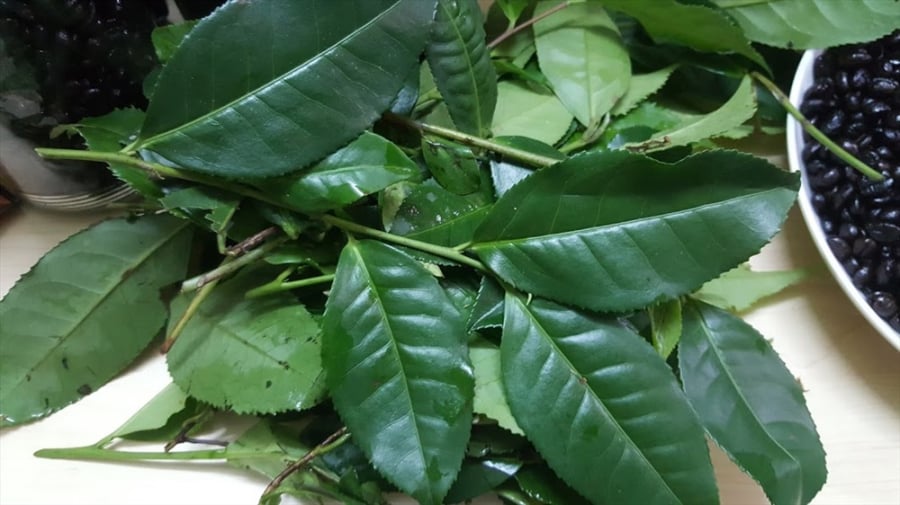Braised fish is a popular dish in Vietnamese family meals. Every person and every household has their own unique braising techniques. The following article will guide you on how to braise fish to achieve a delicious and authentic flavor.
Braising Fish with Fresh Tea Leaves
Many people struggle with the fishy smell when braising, which can diminish the appeal of the dish. To effectively eliminate this odor, use fresh tea leaves. Not only do they neutralize the fishy scent, but the tea leaf infusion also helps firm up the fish meat.

Tea Leaves are Excellent for Removing Fishy Odor
Additionally, pay attention to the fish preparation. It is recommended to rub the fish with coarse salt, focusing on the skin and belly, and then rinse thoroughly.
When cleaning the fish, remove the fins and the black membrane inside the belly. For slippery-skinned fish like basa, snakehead, catfish, or eel, pour hot water (70-80°C) over them and then scrape off the slime. This will ensure the fish is clean and free from any fishy smell.
Alternatively, you can soak the fish in rice water for about 10-15 minutes to reduce the fishy odor.
Marinating Fish to Eliminate Fishy Smell and Enhance Flavor
To ensure the braised fish is tasty and free from fishiness, marinate it before cooking, but avoid using excessive spices that might overpower the natural flavor of the fish.
After cleaning and cutting the fish into sections, place it in a pot. Add half a teaspoon of good-quality fish sauce, a pinch of seasoning powder or salt, and some finely chopped shallots and sliced lemongrass (optional). Let the fish marinate for about 1-2 hours to absorb the flavors. Marinating also helps firm up the fish meat.

Marinating Fish to Enhance Flavor and Freshness
Tips for Choosing Fresh and Delicious Fish
Start by examining the eyes of the fish. Fresh fish will have bright, clear eyes with a greenish-black color and a lively appearance. The eyes should not be cloudy or bulging.
The tail of the fish should be full and not bent or deformed. The skin should be smooth and free from any flaking or bleeding.
When gently pressing on the fish meat, it should spring back quickly to its original shape without any indentations.
Fresh fish will sink in water and not float or turn belly-up.
Braising Fish to Perfection
The ingredients for braising the fish are as follows:
– 1 kg of mackerel, snakehead, or basa, or any fish of your choice
– Good-quality fish sauce
– 1 teaspoon of ground pepper, 2 teaspoons of molasses, 1 teaspoon of seasoning powder, 2 teaspoons of sugar
– A few chilies, 1 teaspoon of minced garlic, 1 teaspoon of minced shallots
– A few lemongrass stalks, sliced
– A handful of fresh tea leaves, boiled to make an infusion.

Perfectly Braised Fish
Place a pot on the stove and heat it up. Add a teaspoon of cooking oil and a teaspoon of sugar, cooking over low heat until the sugar turns a caramel color. Then, add the shallots and garlic, sautéing until fragrant, followed by a teaspoon of fish sauce. For braised fish, it is best to use pure fish sauce to neutralize any unpleasant odors and tenderize the fish meat, enhancing its flavor.
Turn the heat down to the lowest setting to prevent burning the shallots and garlic. Arrange the fish in the pot, adding a touch more fish sauce and enough tea leaf infusion to just cover the fish. Then, season with half a teaspoon of seasoning powder, 1 teaspoon of ground pepper, 2 teaspoons of sugar, and 2 teaspoons of molasses. Top with whole chilies and shallots, peeled but left whole.
Braise over high heat until the liquid has mostly evaporated, then turn off the heat and let it sit for about 1-2 hours. Afterward, braise again over low heat until the sauce thickens and becomes sticky.
The Ultimate Guide to Delicious, Fresh and Tasty Mudfish: Say No to the Fishy Smell!
The humble braised mudfish is a delicious and mouthwatering dish, a true staple in any family meal. To prepare a pot of braised mudfish that is not bitter and tastes absolutely divine, it is essential to start with live, fresh mudfish. Removing any bitterness and carefully selecting the right spices for marination and cooking will ensure a flavorful dish.
Mistakes That Ruin the Taste and Nutrition of Your Cooked Fish
“Fish are an excellent source of protein and provide a complete amino acid profile, as well as essential minerals that are beneficial to our health. However, improper cooking methods can not only ruin the delicate texture of the fish but also destroy its valuable nutrients. Join us as we explore the best ways to prepare and cook fish to retain its nutritional goodness.”
The Secret to Odorless, Tender Braised Fish: A Guide to Delicious Results, Whether You’re Cooking Sea or Freshwater Catch
Introducing the ultimate guide to eliminating that fishy odor from your seafood delights! No more holding back on that delicious salmon or trout, as we bring you simple yet effective tips to ensure your seafood dishes remain odor-free. It’s time to embrace the ocean’s bounty without any unpleasant smells!






































